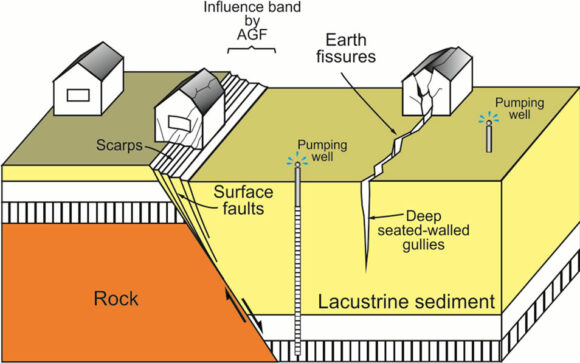The sinking of parts of Mexico City into the former lake bed on which much of it is built is well documented, but to what extent does subsidence also affect other Mexican cities?
Estell Chaussard and her co-authors considered this question in their article entitled “Magnitude and extent of land subsidence in central Mexico revealed by regional InSAR ALOS time-series survey.” Subsidence, often resulting from over-depletion of ground water, has a range of human impacts, including decreased supply of safe water, an increase in flood risk, and a greater hazard threat from building or street failure.
In their time-series analysis of more than 600 Synthetic Aperture Radar (InSAR) images of central Mexico, the authors found evidence of significant subsidence in seventeen cities, including sixteen cities with a population of 100,000 inhabitants or more. The cities affected (with their population in parentheses) are listed here from east to west:
- Puebla (2,500,000)
- Mexico City (21,000,000)
- Toluca (427,000)
- Querétaro (825,000)
- San Luis de la Paz (101,000)
- Celaya (266,000)
- San Luis Potosí (936,000)
- Morelia (537,000)
- Salamanca (144,000)
- Irapuato (317,000)
- Silao (147,000)
- León (1,400,000)
- Aguascalientes (735,000)
- Zamora (186,000)
- Guadalajara (3,800,000)
- Ahuacatlán (6,500)
- Tepic (261,000)
Their analysis suggested that the rates of subsidence over a two-year period were nearly constant at most locations, typically between 5 and 10 cm/yr. (In contrast, subsidence in Mexico City was around 30 cm/yr, in line with previous studies.)

Ground failure by groundwater withdrawal subsidence. Credit: Natural Science, Vol. 6, No 3, 2014.
An earlier study – Subsidence risk due to groundwater extraction in urban areas using fractal analysis of satellite images – had found that the intense groundwater pumping regime in Irapuato for urban supply and agriculture (the area is one of Mexico’s main strawberry-growing centers) had resulted in 18 subsidence fault systems with a total length of 27 km, causing damages to more than 200 houses.
Meanwhile, previous work in nearby Celaya – Subsidence in Celaya, Guanajuato, Central Mexico: implications for groundwater extraction and the neotectonic regime – found that subsidence in that city was due to a complex combination of factors, and not entirely due to excessive groundwater extraction. Most earth fissures in the Celaya area were related to pre-existing structural features, and the authors suggested that thermal springs also appeared to play a role.
References:
- Chaussard, Estelle; Amelung, Falk; Wdowinski, Shimon; Cabral-Cano, Enrique. 2013. “Magnitude and extent of land subsidence in central Mexico revealed by regional InSAR ALOS time-series survey.” EGU General Assembly 2013, Vienna, Austria.
- Huizar-Alvarez, Rafael, et al. 2011. “Subsidence in Celaya, Guanajuato, Central Mexico: implications for groundwater extraction and the neotectonic regime.” Geofísica Internacional[online]. 2011, vol.50, n.3, pp. 255-270.
- Rodriguez, Ramiro, et al. Subsidence risk due to groundwater extraction in urban areas using fractal analysis of satellite images. Geofísica Internacional[online]. 2012, vol.51, n.2, pp. 157-167.
Related posts:
- Why are some parts of Mexico City sinking into the old lakebed?
- How fast is the ground sinking in Mexico City and what can be done about it?
- Ground subsidence in Mexico City threatens 10,000 homes
- More ground cracks appearing in Mexico City and the Valley of Mexico (Jan 2011)
- Subsidence incident leads to demolition of 31 homes in the State of Mexico
- Was this fissure near Hermosillo caused by subsidence or by faulting?
Sorry, the comment form is closed at this time.